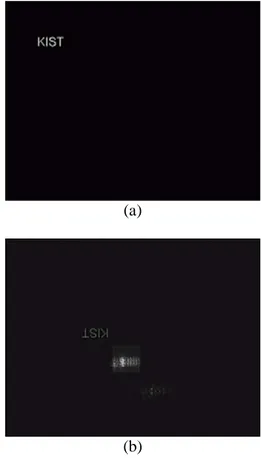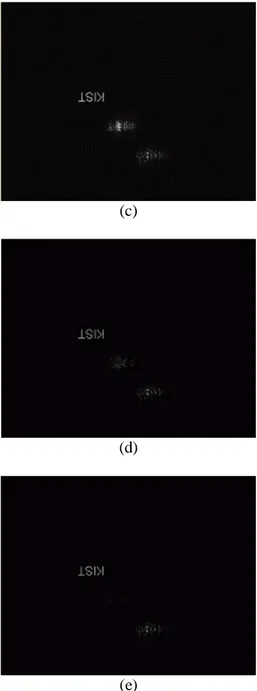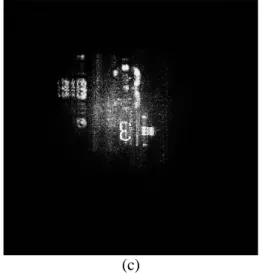P2-31 / K. –H. CHoi
IMID 2009 DIGEST •
Abstract
In this study, the 0-th order diffraction could be efficiently removed with the obtained data for one hologram using the numerical reconstruction method. This method has a reduced data acquisition and processing time compared with the existing method wherein the data for two or more phase holograms are obtained for regeneration, and efficiently eliminates the 0-th order diffraction.
1. Introduction
Holography technology, which regenerates objects using the object beam and reference beam that contain the information of the objects, is widely applied to the precision nano-area measurement and display fields. The problems caused by holographic structure including the 0-th order diffraction and twin image have to be overcome in the holographic measurement and display. A study on the method to eliminate the 0-th order diffraction was performed to overcome 0-these problems [1], and a study to increase the quantity of data obtained from the digital holography microscope system by controlling the measurement area of objects was also performed [2].
In this paper, the Fourier Transform is applied by using the hologram achieved through the numerical hologram generated by the CGH method and the actual hologram interferometer. Through this Fourier transform process, it transforms the three dimensional object information into data in frequency space. The Fourier transform data of the amplitude hologram transformed like this eliminated the 0-th order diffraction in the Fourier transform space, and using the inverse Fourier transform, it calculated the
numerical hologram being eliminated with the 0-th order diffraction element [58-59]. The advantage of the numerical hologram using this method is that it is possible to eliminate the numerical 0-th order diffraction of the same concept in the optical Fourier transform with the method of eliminating the 0-th order diffraction in the hyper plane of the Fourier Transform lens. I eliminated the 0-th order diffraction numerically and showed its result in this paper. The existing 0-th order diffraction elimination method records the hologram 2 or more times; however, this method has a problem of re-recording the hologram data in a same condition, and there is a method of using the image processing technique, but is has some trouble in initial data loss due to only using the amplitude data and incomplete elimination of the 0-th order diffraction. The method used in this paper has an advantage that it can change the condition of the early hologram information loss and the 0-th order diffraction elimination and can get the reconstructed image as a result of that.
2. Main Subject
In this study, the Fourier transform was applied using the numerical hologram generated by the CGH method and the actual hologram obtained from the digital holography microscope system. The 3-D object information was transformed into the data through the Fourier transform in the frequency space. The 0-th order diffraction was eliminated from the Fourier transform data of the amplitude hologram, and the numerical hologram without the 0-th order diffraction light was calculated using the inverse Fourier transform. The advantage of this method is that, in the
A study on the Variable Elimination of the 0-th order
Diffraction Using the Fourier Transform in the Digital
Holography Microscope System
Kyu-Hwan Choi* and Sung-Kyu Kim
Imaging Media Research Center, Korea Institute of Science and Technology, P.O.Box 131, Cheongryang, Seoul 130-650,
Tel.:82-2-958-5794, E-mail: choi0158@kist.re.kr
Keywords: Holography, Digital Holography, Fourier Transform, 0-th order diffraction
P2-31 / K. –H. CHoi
• IMID 2009 DIGEST
optical Fourier transform, the numerical 0-th order diffraction can be eliminated in the same way as that of the elimination of the 0-th order diffraction from the Fourier transform lens hyperplane.
The light strength distribution using the Fourier transform can be given by Eq. 1.
2 2 2 ( ) ( ) 2 1 ( , ) ( , ) k i u v i u v f f f U u v e U e d d i f π ξ η λ ξ η ξ η λ + − + =
∫∫
(1)A removal function was introduced to numerically apply the feature of the high pass filter to the optical Fourier transform. The purpose of the removal function is the elimination of the 0-th order diffraction and, by freely selecting the elimination area, the eliminated 0-th order diffraction and the data loss of the numerically generated 3-D object can also be compared because the 0-th order diffraction belongs to the low frequency range on the hyperplane.
The formula of the removal function is given by
( , )
0
1
B u v
if u
a and v
b
else area
=
<
<
=
(2)The removal function eliminates the data within the positive and negative a(b) values in the horizontal / vertical direction from the horizontal/vertical center axis on the hyperplane of the Fourier lens, and preserves the Fourier transform data in the other areas. A new function obtained by applying the removal function B u v( , ) and inverse Fourier transform to the optically Fourier-transformed function Uf( , )u v is shown in Eq. 3. 2 2 2 ( ' ' ) ( ' ' ) 2 ( ', ') ( , ) k i i u v f f new f U i fe U u v e dudv π ξ η ξ η λ ξ η = λ − +
∫∫
+ (3)Thus, the inverse Fourier transform that involves the optical Fourier transform and the elimination of the 0-th order diffraction could be numerically calculated.
3. Experiment Result
Fig. 1 shows the reconstruction of the object (KIST) that was formed by applying the CGH method, for the cases with and without the removal function. It indicates that the 0-th order diffraction is efficiently eliminated when the removal function is used. Fig. 1
shows the hologram of the object ‘USAF Group Number 3’ and its numerical reconstruction by the digital holography microscope system. Without the removal function, there is loss of the object in the reconstruction image (Fig. 1(a)). When it was reconstructed with the removal function, however, the area that would have been lost due to the 0-th order diffraction could be efficiently reconstructed.
For the restrict 0-th order diffraction, we should include every item contributing to the creation of the hologram in the calculation; therefore, the experiment result about the 0-th order diffraction elimination for the simulation result with every item being included in the calculation is Fig. 1. The target object in Fig. 1 is Fig. 1 (a) and the CGH of the case where the target object is 700mm away from it was calculated, and the result of the numerical reconstruction with the eliminated 0-th order diffraction when the coefficients of the 0-th order diffraction elimination function are set to “0,” “1,” “10” and “20” is (b), (c), (d) and (e) of Fig. 1. In this experiment, there was no big difference in visual confirmation when the coefficient of the removal function was more than “20.”
(a)
P2-31 / K. –H. CHoi
IMID 2009 DIGEST • (c)
(d)
(e)
Fig.1. Compare of the 0th order diffraction ratio. (a) Object “KIST” made by CGH method
(b) Reconstruction image without applying removal function
(c) Reconstruction image with applying removal function 1
(d) Reconstruction image with applying removal function 10
(e) Reconstruction image with applying removal function 20
The degree of elimination of the 0-th order diffraction showed in the result of Fig. 1. is expressed as Table 1. As we can see in Table 1, the elimination of the 0-th order diffraction, unlike the beginning of
the elimination, shows that the 0-th order diffraction is continuously decreased even where the coefficient of the elimination function is 20 or more.
TABLE 1: Degree of the 0-th order diffraction elimination: Target object “KIST”.
Value of RF Function 0 1 10 20 Object “KIST” (Dist. 700 mm) (ration of the 0-th order diffraction) 75.9 37.5 21.9 7.8 (a) (b)
P2-31 / K. –H. CHoi
• IMID 2009 DIGEST (c)
Fig.2. Target of the Object ‘USAF Group Number 3’ and its numerical reconstruction by the digital holography microscope system.
(a) Reconstruction image without applying removal function
(b) Reconstruction image with applying removal function 20
(c) Reconstruction image with applying removal function 50
Fig. 2. shows the hologram of the object ‘USAF Group Number 3’ and its numerical reconstruction by the digital holography microscope system. Without the removal function, there is loss of the object in the reconstruction image (Fig. 2(A)). When it was reconstructed with the removal function, however, the area that would have been lost due to the 0-th order diffraction could be efficiently reconstructed.
The increase rate of the removal function was 20, and 50 for Figs. 2(b) to (c), respectively.
4. Conclusion
The present thesis calculated a hologram numerically by applying a hologram calculated with the CGH method to inverse Fourier transformation by using Fourier transformation and a removal function.
The 0-th order diffraction light was effectively removed without information loss of the three dimensional substance by using a hologram calculated like this. Also, the removal degree of the 0-th order diffraction light according to coefficient change of a removal function of the 0th order diffraction light was compared with the loss degree of three dimensional substance’s information having the initial amplitude of
hologram.
As a result of being applied to the digital holographic microscope system by applying it to real substance’s data with the simulation result like this, the 0th order diffraction light’s conditions having no loss of object substance’s data were confirmed.
.
4. References
1. I. Yamaguchi and T. Zang, Opt. Lett., vol 22, no 16, p.1268-1270 (1997)
2. Kyu-Hwan Choi, Jung-Young Son, Won-Gun Jang and Sung-Kyu Kim, JJAP, vol.48, 022501-1-7, (2009)


